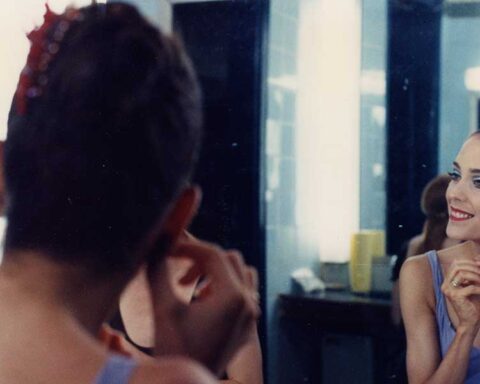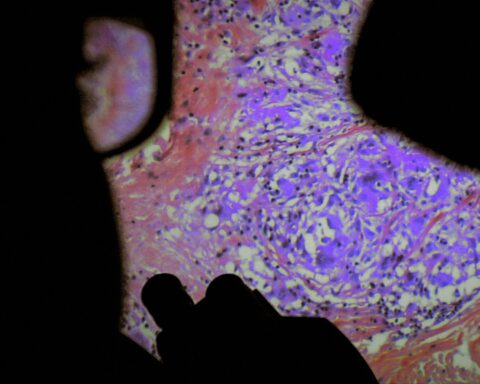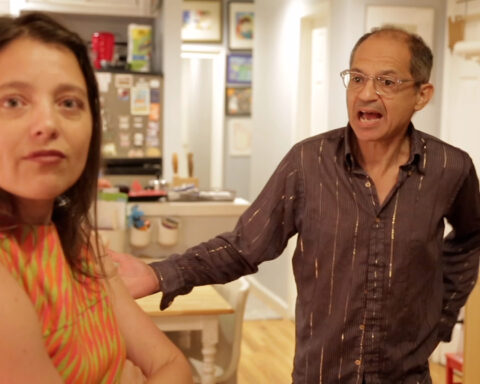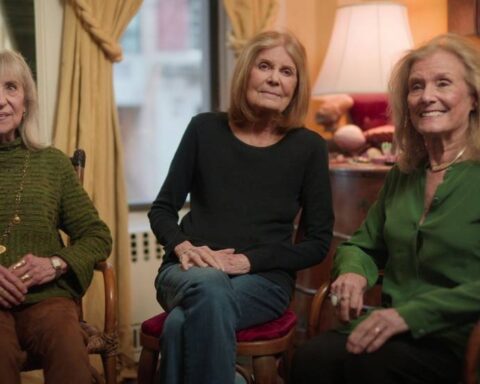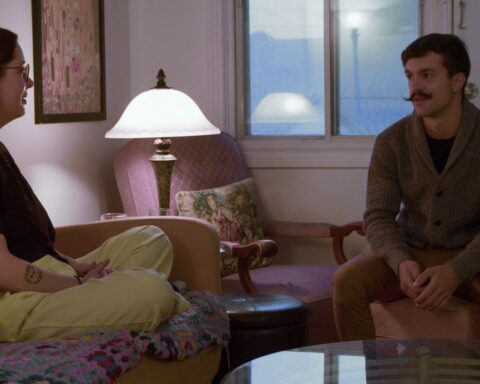JUDGE JUDY MEETS FREDERICK WISEMAN in French filmmaker Raymond Depardon’s compelling feature doc, 10e Chambre, Instants D’Audiences (The 10th District Court, Moments of Trials), a hit on the 2004 film festival circuit. Depardon, a world-renowned photographer and eminent director, spent seven tenacious years gaining “carte blanche” access to film inside the Paris courtroom of Madame Justice Michèle Bernard-Requin. Depardon opens his latest courtroom installment by clarifying that only portions of trials will be shown; then he lets his camera linger without apology while capturing ‘real’ time.
Nearly 100 trials were documented by Depardon and his crew. The director narrowed that number down to 12 cases he lets us witness, and while many of the accused display engaging circumstances and imaginative defense strategies, it’s very much Judge Requin who sets the tone of his engaging film. A charismatic figure, she also appeared in Depardon’s earlier judicial doc, Caught in the Act, made a decade ago when she was a prosecutor. Viewers will be struck by similarities between France’s smart-as-a-whip Judge Requin and America’s quick-with-a-quip Judge Judy. Their cases also run a similar gamut of criminal occurrences, yet the Judge Judy show is reality TV, and 10e Chambre is set to become a cinema verité classic. What mechanisms has Depardon drawn upon to differentiate his courtroom ‘realism’ from TV’s endless smorgasbord of ‘reality’ courts dished up regularly on the airwaves?
Courtroom ‘drama’ has come to mean ‘high drama’, played out to select jury pools in packed courtrooms, with ‘star’ lawyers defending the famous, or people who were once unknown but have since risen to fame through a barrage of media coverage about their grisly crimes. For instance, audiences are committed to following media-made courtroom ‘star’ Scott Peterson; once relatively unknown, he was elevated to fame after being charged with the murder of his wife Lacey and their unborn child. Meanwhile, the mundane, mainly paper-pushing trials of unfortunates charged with petty misdemeanors, heard only by a Judge in a small courtroom and absent of media hype, has never held much attraction to TV or film audiences.
Refusing to capture titillating cases with ‘Bernardo’ type psychopaths, or otherwise seek out the rich-and-famous to occupy the defendant’s chair, Depardon purposefully chooses people facing common misdemeanor charges for the investigations he wishes us to consider. We hear rap sheets of petty crimes, and watch trials played out by a series of downtrodden defendants. 10e Chambre leads the viewer on a journey through everyday criminal occurrences, beginning with a few drinking and driving charges, shifting to a relationship-stalking saga, moving along to a pickpocket robbery, and escalating to possession of a gun. It makes for a fascinating study of courtroom protocol, but even more engaging is the tragedy and bravado of the human condition, played on both sides of the law.
We are immediately drawn to a middle-aged female defendant who looks every bit as innocent as anyone’s mum. She has been charged with having too much alcohol in her system before driving her car home after dining at a Paris bistro with her girlfriends. She explains (and means it) that the problem isn’t so much about her drinking the extra glass of wine at dinner, but rather, that she had the unfortunate situation of being stopped by the officer who charged her. She appears short on memory recall, or could be playing coy, and is likely a combination of both. The strategy of her defense is endearing, and she is totally befuddled by the weight of the legal proceedings for an offence she perceives to be mild. She speaks rapidly, and hopes to convince the Judge to let her off without penalty.
Judge Requin is amused, but not convinced, and eventually gets the defendant to agree that it was wrong to drive after having the extra drink. The scene shows a captivating game of persuasion played out between two intelligent women, resulting in a double win. Judge Requin responds in kind by lowering the maximum fine to a minimum penalty. And although she must pay something, the woman is pleased at her outcome, having at least won a little.
In another case, a young woman has charged her former boyfriend with repeatedly making threatening phone calls to her after their breakup. He outright denies it and then lets his lawyer step in to defend him. (This is the only case in 10e Chambre with both defendant and victim present in court; it’s more akin to the TV reality format.) The lawyer argues that love and hate are the same feeling, with great love being capable of great hate, so that when someone, (such as the defendant), has loved and suddenly starts showing hate, it should be understood that the same feelings of love are actually being expressed.
The audience at the Toronto International Film Festival appeared to be dumfounded by the dreadful job the lawyer was doing, and the audacity and ridiculousness of his argument. Depardon’s camera only has to capture one reaction shot of Judge Requin to show that his client is doomed. When she presents her finding of guilt, Requin delivers the maximum penalty.
And so it goes—a series of charges get read aloud, tall stories of denial are heard, and bits of factual evidence get filtered through a set of laws. It’s all highly detailed and slow paced. The audience takes up the position of the Judge, aligning with the findings of Requin who accurately reflects the evidence she hears in her decisions, including whether the defendant refuses to understand the repercussions of their actions or accepts their fate. Her sentences favour leniency to those who admit their guilt and are willing to improve themselves, and severity to those who deny guilt and refuse to budge.
Using a direct cinema approach, Depardon doesn’t place himself in the film or inject interviews or voice over, relying instead on his fixed verité camera to say everything about the defendants negotiating their trial pleas. He pulls viewers into his on-screen world and lets them judge the circumstances, all of which are sharply focused through his powerfully minimalist approach. At times audiences may begin to wonder if they are participating as assessors of social issues or behaving more like navel-gazing courtroom voyeurs, an effect Depardon supports by insisting they are at all times engaging in both. This is the value of verité; it is an approach that offers a purposeful portal into hidden worlds the camera enters, allowing audiences to experience those worlds momentary as visiting voyeurs.
Frederick Wiseman is the undisputed grandfather of thought-provoking, institutionally based cinema verité feature docs, (Titicut Follies, High School, Welfare, Hospital and Domestic Violence to name a few). Wiseman set up his verité cameras in the milieu of courtroom activity back in 1973, to make Juvenile Court, a groundbreaking judicial study at the time, which still holds up three decades later.
Depardon and Wiseman both undertook direct cinema quests for understanding within the occurrences of daily criminal activity, with Wiseman’s subject being American youth and Depardon’s being adult misdemeanors in France. In Juvenile Court, we witness results that are common among Wiseman’s classics, with the keepers badgering the kept, in ways that seem normal to people inside the institutional construct, but abnormal to audiences outside the institution’s walls.
The main characters emerging in Juvenile Court are the accused youth. There is a nerdy male teenager charged with fondling a young girl while babysitting her, a pimply faced drug user charged with selling LSD to undercover cops, and a clean-cut youth who can’t stop crying while he is being sent to jail despite his steadfast pleas of innocence. The audience can see through their net of lies, spun to protect themselves, which is precisely the same mechanism of defense the characters populating 10e Chambre use, except in 10e Chambre the main character focus is unquestionably the Judge.
Judge Requin outwardly displays distaste when she is being toyed with, but manages to refrain from overly showy exaggerations of disapproval that populate the trials of reality TV’s Judge Judy. Audiences can relate to the criminal situations being faced by the defendants in 10e Chambre, and they ultimately come to align with the evenhanded yet shrewd ‘you’re-not-going-to-pull-thewool- over-my-eyes’ decisions of Judge Requin.
The Judge Judy show is the most popular of the television court genre, and is also in the top ten syndicated shows of all genres. Judge Judy maintains her weekly half-hour TV status not by the cases she hears, but by her attitude; hence the show’s handle, ‘justice with attitude.’ She has an uncanny recognition for lackluster liars, as does Judge Requin. But in a style much different than Requin’s, Judge Judy wastes not a second in calling people on their ‘stories,’ putting them in their place with her showy decisions, which are often pumped up for audience entertainment value. Judge Judy has shadings of Jerry Springer’s appeal; her ability to humiliate her ‘guests’ scores points with her audiences.
Depardon knows that not all courtrooms are this showy. One need only stroll through College Park courts or old City Hall, where everyday people are tried, to see that only those required to be there are milling about. People do not go out of their way to observe a woman who has had a bit too much wine while dining with her girlfriends. Thus begins the value of Depardon’s approach to courtroom ‘drama’. What you discover over time, and by witnessing enough of these scenarios, is how much the courtroom of the common people reflects the human condition of ordinary citizens.
While it is fascinating to gawk at trials of the rich and famous, we are not like them. We are likely incapable of the gruesome murders or serial crimes we tune in to see, and we credit ourselves with being beyond the reproach Judge Judy doles out. However, one drink too many before driving home, accompanied by a serious appeal for leniency, is a situation which most of us can readily identify. The Judge Judy show is escapist TV, and yet it is this very milieu that Depardon risks banking his feature film investment on, yielding stunning results for those who commit to his 105-minute presentation. The willingness to park oneself in a darkened cinema for almost two hours is mandatory for witnessing what unfolds slowly in 10e Chambre.
For most people, courtrooms are far more appealing when the stakes are high, the crime is gruesome or the accused is noteworthy. Television cameras trained on OJ Simpson raised the bar on audience expectations inside a ‘real’ court, observed in ‘real’ time. Audiences readily tune in for the stars. After all, who wouldn’t want to witness Martha Stewart take command in the courtroom, suggesting that the Judge get on with her five-month jail sentence by fall so she is out in spring to tend her garden!
With TV courtroom coverage of celebrities readily available, and reality court shows with ‘star’ Judges being so ubiquitous (including The People’s Court, where Judge Judy’s husband presides), has there been a heavy burden of entertainment value heaved on the shoulders of verité? Audiences can rightfully expect courtroom scenes to be ‘dramatic’ when it comes to fictional films, but should they expect the same level of ‘drama’ in reality?
In the 70s when Juvenile Court was made, viewers could expect to see a distinct difference between a half-hour reality TV show and a full-length verité film. Candid Camera did not tread on the toes of Salesman. But lines defining reality TV and verité have become blurred. Unobtrusive cameras capturing reality have given way to film techniques meant to keep the MTV genre engaged. Most contemporary docs rely on fast cuts, music overlays and visual eye-candy instead of letting cameras linger on people who have fascinating things to say or interesting characteristics to reveal.
The microscopic view Depardon offers us feels purely observational even though it is highly planned and purposeful. He chooses where to place his camera, who will be filmed, the order of the trials and the editing within each scene. He decides where our attention should be and what our eventual conclusions should reflect.
Depardon allows us to experience a sphere we normally catch mere glimpses of, and he calls into question the very use of cinema verité as the voyeuristic mechanism of choice to capture his topic. He engages us, lets us unravel minimal judicial moments, allows us to witness small insights about human behaviour, and gives us reflections of real courtroom encounters. His camera, which he operates, is purposely held at eye level, to portray his subjects as they are, without imposing angles to look down at defendants (from the Judge’s bench) or up at the Judge (from the defendants’ box).
Ultimately we get to make up our own minds about what we see and hear in 10e Chambre, by way of a channeled view into Depardon’s well constructed mirror, where the reflections take us deeper into ourselves. Reality TV offers fodder, while cinema verité still covers topics that challenge us, letting us reflect on the human condition and ponder how the world could be made a better place.




